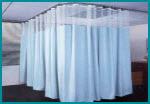It’s Not What Is Behind The Curtain, But What Is On It!

HARD FACTS ABOUT SOFT SURFACES
There are numerous resources available that discuss the importance of cleaning and disinfection of hard surfaces, and the laundering of fabrics and linens; however there has been very little focus on the potential risk associated with soft surfaces in recent years. There are numerous clinical studies from around the world that have demonstrated that soft surfaces in healthcare settings, such as privacy curtains, uniforms, upholstered fabrics, and patient gowns and linens, are contaminated with pathogenic bacteria, including multidrug resistant organisms (MDROs). These studies have also demonstrated that these bacteria can survive on soft surfaces for weeks, and can be easily transferred to healthcare workers’ hands, increasing the risk that these bacteria may be transferred to a susceptible patient.
A recent study, by Ohl, et al, called out several factors that make privacy curtains that separate patient care areas a potentially important site of environmental contamination.
- Healthcare workers, patients and visitors frequently touch privacy curtains which may contribute to the transfer of bacteria to curtains.
- Evidence suggests that pathogens contaminating privacy curtains may be picked up on healthcare workers’ hands which may increase the risk that they could travel to a patient by way of the healthcare worker’s hand
- Privacy curtains are difficult to clean and disinfect, and in many cases because of this, they are infrequently changed, or only changed if visibly soiled or during an isolation discharge, which makes them a potential vehicle for transmission of pathogens from a prior room occupant to a new patient
The study, run over a 3-week period, swabbed 180 samples of the leading edge of 43 curtains in 30 rooms across the ICU and medical ward, concluded that privacy curtains can become rapidly contaminated with pathogenic bacteria, with over 90% of new curtains showing contamination within one week, and 95% of the curtains demonstrating contamination on at least one occasion. The study demonstrated that privacy curtains are frequently and quickly contaminated with potentially pathogenic bacteria, including MDROs.
Salah S. Qutaishat, PhD, CIC, FSHEA, Senior Clinical Advisor, Infection Prevention, Diversey, also feels there is a strong relation between hard and soft surfaces and cross-contamination. “Both hard and soft surfaces in patient care areas are touched frequently. Hands can become contaminated by touching both; so, cleaning and disinfecting both surface types is critical to a successful and effective infection prevention program.”
Cleaning and sanitization of soft surfaces should be an important part of an effective infection prevention program. Because germs are invisible and these surfaces are often harder to clean, it may not be clear when these surfaces need to be addressed. Many facilities have programs in place regarding when privacy curtains should be changed; but this is a labor-intensive task, and there is certainly room for an easier method to address soft surfaces on a more frequent basis. The next step is to follow through from guidance to implementation and make sure we are taking all the precautions we know are available today.
The EPA has recently allowed soft surface sanitization claims. Unlike hard surface disinfectant claims, soft surface claims are limited by the EPA, to “sanitizer” versus “disinfectant” claims. The efficacy of a chemical used for sanitizing or disinfection depends on its ability to reduce the contamination level.
The EPA Performance Standard for non-food contact sanitizers requires a reduction of at least 99.9% (a 3-log reduction) in the number of each test microorganism. The sanitizer claim is based on laboratory testing of only two bacterial (not virus or fungi) pathogens (Staphylococcus aureus and either Klebsiella pneumoniae or Enterobacter aerogenes). It is important to note that soft surface” claims are limited, by the EPA, to “sanitizer.” The disinfectant standard requires a higher level of reduction, 99.9999% reduction/kill (a 6-log reduction).
This requirement is further supported by a recent study published by William Rutala, PhD, that demonstrated the effectiveness of “improved hydrogen peroxide” disinfectants as soft surface sanitizers.**
The great news is that there are now multiple products that are registered effective by the EPA for soft surface sanitization which can be incorporated into your infection prevention program.
To ensure your facility has a comprehensive approach to preventing the transmission of pathogens, it should incorporate processes and work flow to ensure that both hard and soft surfaces are covered in your facility’s cleaning and disinfecting protocols. This includes targeting soft surfaces in patient and exam rooms (privacy curtains), waiting and reception areas (couches and chairs) and workstations (office furniture, desktops, etc.).
Recommended Considerations include:
Continued focus on Hand hygiene practices of staff, patients and visitors.
1) Laundering protocol for linens, uniforms, privacy curtains, and other soft surfaces in your facility which includes frequency and method guidance.
2) Routine cleaning and disinfection of hard surfaces and soft surfaces that cannot be laundered.
3) Training and monitoring program for staff, to ensure protocol for all surfaces and areas are followed.
Although there is more research needed in this area, there is strong evidence to suggest that a programmatic approach to cleaning and disinfection, including both hard and soft surfaces, will reduce the risk for your patients, and provide improved outcomes.
* References:
1. Ohl M, et al. Hospital privacy curtains are frequently and rapidly contaminated with potentially pathogenic bacteria.” American Journal of Infection Control. 40:10 (2012): 904-906.
2. DeAngelis DL, et al. Hospital privacy curtains: Cleaning and changing policies — are we doing enough? American Journal of Infection Control. 41 (2013):S25-S145.
3. Neely AN, et al. Survival of enterococci and staphylococci on hospital fabrics and plastic. J Clin Micro. 38.2 (2000):724-726.
4. Neely AN. Persistence of microorganisms on common hospital surfaces. Infection Control Resource.
5 Noskin GA, et al Persistent contamination of fabric-covered furniture by vancomycin-resistant enterococci: implications for upholstery selection in hospitals. Am J Infect Control. 28.4 (2000):311-3.
** Source: Efficacy of Improved Hydrogen Peroxide against Important Healthcare-Associated Pathogens
Author(s): William A. Rutala, PhD, MPH: Maria F. Gergen, MT (ASCP): David J. Weber, MD, MPH
Infection Control and Hospital Epidemiology, Vol. 33, No. 11 (November 2012), pp. 1159-1161
Published by: The University of Chicago Press on behalf of The Society for Healthcare Epidemiology of America.

